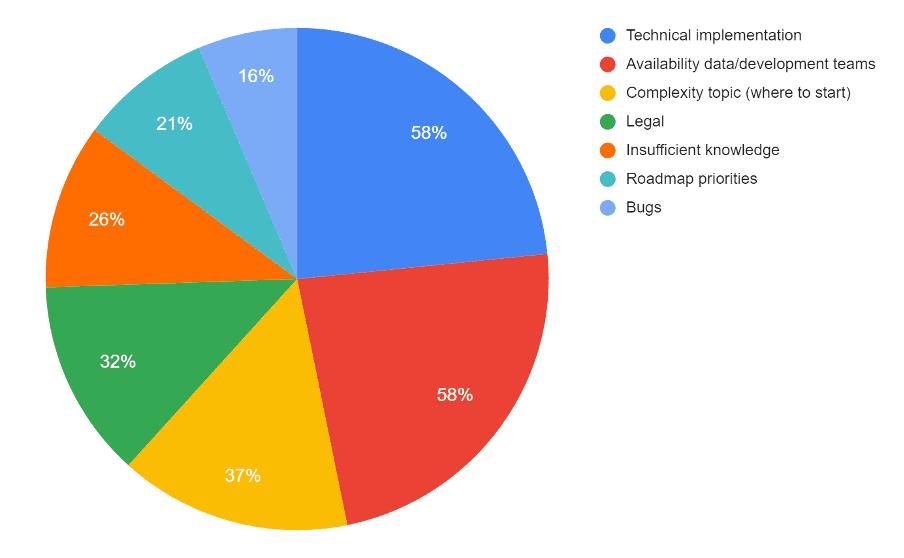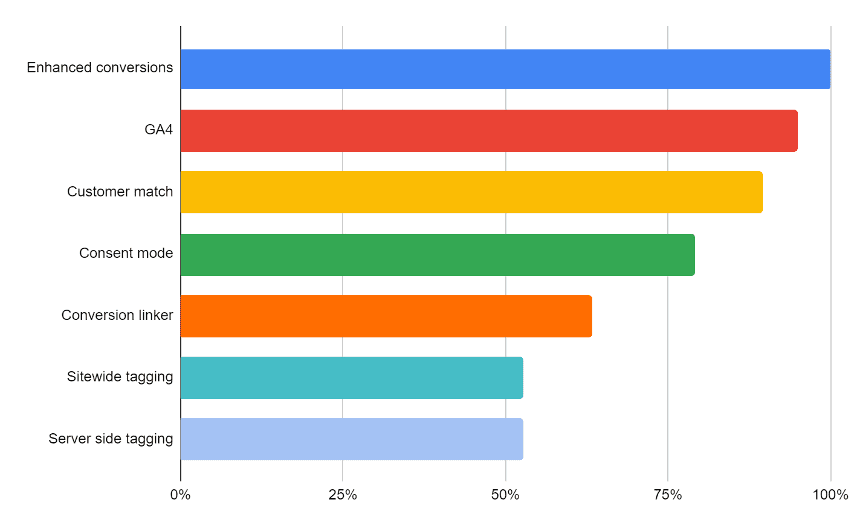Als Online-Vermarkter macht man keinen Hehl mehr daraus, dass die Zukunft in dendata liegt. Neben dieser Gewissheit gibt es aber auch vieles, was wir noch nicht wissen. Bei der Vorrecherche von Nicole Kuper und Nick Oltvoort von der VIA Taskforce Search wurde schnell deutlich, dass viele ihrer Paid Search-Kollegen Fragen zu diesem Thema haben. Was genau bedeutet der Wechsel von data zudata , welche Lösungen gibt es und wo sollte man ansetzen? "Um diese Fragen zu beantworten, haben wir damit begonnen, die größten Hindernisse und Lösungen fürdata aufzuzeigen. Nicht, weil wir all das Wissen im Haus haben, sondern hauptsächlich, um Ihnen zu zeigen, dass Ihre SEA-Kollegen die gleichen Fragen haben. Tatsache ist, dass vieles noch unklar ist. Aber wenn wir unsere Kräfte bündeln, können wir gemeinsam großartige Lösungen finden", sagen Nicole und Nick.
In diesem Artikel finden Sie einen umfassenden Überblick über die Hindernisse, auf die Sie bei der Implementierung vondata im Bereich Paid Search (SEA) stoßen. Außerdem geben wir Tipps zum Umgang mit diesen Hindernissen und einen Überblick über bestehendedata , damit Sie sofort loslegen können!
1. Einleitung - Vorrang für die Privatsphäre
Aber lassen Sie uns zunächst einen Schritt zurückgehen. Wo hat die Geschichte mit dendata eigentlich angefangen und warum? Trotz früherer Cookie-Gesetze begann der Wandel eigentlich mit Änderungen in der Datenschutzgesetzgebung. Am 25. Mai 2018 trat das AVG in Kraft, das in Europa auch als GDPR bekannt ist. Im Mittelpunkt dieses Gesetzes stehen "Einwilligung und Transparenz". Das bedeutet, dass ein Nutzer wissen muss, ob Kennungen verwendet werden und welche personenbezogenen data verarbeitet, gespeichert und dann für Zwecke wie (targeting und Werbung verwendet werden. Außerdem muss der Nutzer aktiv angeben können, ob er seine personenbezogenen data speichern möchte oder nicht.
Infolge der Durchsetzung dieser Änderungen mussten sich viele große Parteien anpassen. Safari (Apple) und Firefox (Mozilla) haben bereits beschlossen, 2019 und 2020 cookies von Drittanbietern "standardmäßig" zu blockieren, um alle Nutzer, vor allem aber sich selbst, zu schützen. Chrome (Google) plant dasselbe über die Privacy Sandbox, aber das wird noch eine Weile dauern. Die ersten Pläne wurden für 2022 angekündigt, aber daraus ist nun Ende 2024 geworden. Auch Apple hat mit dem neuen iOS 14.5-Update beschlossen, seinen Nutzern mehr Kontrolle zu geben. Zum Beispiel muss jede App über ein Pop-up um Erlaubnis fragen, ob sie Sie über verschiedene Drittanbieter-Apps und Websites verfolgen kann. Diese aktive Frage wird viele Nutzer dazu veranlassen, sie abzulehnen.
Indem die Datenschutzproblematik bei Browsern und Anwendungen angegangen wird, wird die Vordertür geschlossen. Auf diese Weise können Werbeplattformen viel weniger Nutzer verfolgen und viel weniger Identifikatoren verwenden. Wenn Google im Jahr 2024 mit Chrome (66 % aller Nutzer) zu Apple und Mozilla aufschließt, werden den Werbetreibenden viele data entgehen, was erhebliche Auswirkungen auf die Leistung unserer Werbung haben wird. Dies geschieht jedoch nur, wenn wir in der Zwischenzeit keine alternative Strategie verfolgen und neue Lösungen einführen. Wie können wir also daraus Kapital schlagen? Was sind die größten Hindernisse für den Einstieg in einedata und welche Lösungen werden bereits eingesetzt?
Wir haben unsere Kollegen in einer Umfrage befragt.*
2. Die größten Hindernisse beidata
Bei der Einführung von Lösungen fürdata stößt man auf zahlreiche Hindernisse. Nicht weniger als 95 % der Befragten haben angegeben, dass sie auf Probleme stoßen. Weitere 63 % sind mit der Akzeptanz der Lösungen im eigenen Unternehmen, sowohl auf Agentur- als auch auf Kundenseite, nicht zufrieden. Alle Befragten haben die ersten Schritte zur Umsetzung unternommen. Darüber hinaus arbeiten 79 % bereits an Integrationen, von denen 26 % sehr aktiv sind. 21 % bleiben in der Strategie stecken, weil der Prozess intern verlangsamt wird. Die größten Hindernisse scheinen bei der technischen Umsetzung und der Verfügbarkeit von data und Entwicklungsteams zu liegen, aber auch die Komplexität des Themas spielt eine große Rolle. Nachstehend finden Sie die Ergebnisse.

Kennen Sie diese Hindernisse? Im Folgenden werden wir sie einzeln besprechen und Ihnen einige Tipps geben.
Technische Umsetzung & Verfügbarkeit von data- und Entwicklungsteams
Das größte Hindernis liegt in der technischen Umsetzung vondata . Alle derzeitigen Lösungen erfordern technische Kompetenzen und eine gute Zusammenarbeit zwischen Entwicklern, data und SEA-Spezialisten. Aufgrund des Mangels an dieser Zusammenarbeit sind die Vorlaufzeiten oft länger, aber auch, weildata innerhalb der data und Entwicklungsteams oft nicht genügend Priorität eingeräumt wird. Außerdem müssen alle Beteiligten über ausreichende Kenntnisse verfügen, um das gemeinsame Ziel zu erreichen.
Tipp! Erstellen Sie einen Business Case, der sich darauf konzentriert, welchen Nutzen diedata bieten kann und welche Auswirkungen sie haben kann, wenn sie nicht genutzt wird. Präsentieren Sie diesen dann innerhalb der Organisation, um (interne) Stakeholder von der Dringlichkeit zu überzeugen, aber vor allem, um genügend Unterstützung bei den Stakeholdern außerhalb des data zu schaffen.
Komplexität des Themas und unzureichende Kenntnisse
Es gibt viele Lösungen fürdata , und sie unterscheiden sich je nach Werbeplattform. Außerdem gibt es immer noch viel Unsicherheit, und diese Kombination macht es zu einem komplexen Thema. Es ist auch nicht immer klar, welche Lösungen es gibt, was die höchste Priorität haben sollte und wie hoch die Dringlichkeit ist. Das bedeutet auch, dass die Fachleute und Interessengruppen oft zu wenig wissen, um eine solide Strategie zu entwickeln. Am Ende dieses Artikels finden Sie eine Checkliste, die Ihnen hilft, die Komplexität der einzelnen Lösungen zu veranschaulichen, sowie eine schrittweise Erklärung, wie sie umgesetzt werden können. Um Ihnen den Einstieg zu erleichtern, wurde die Lösung auch mit einem "Prioritätskennzeichen" versehen.
Tipp! Informieren Sie sich im Vorfeld über die verschiedenen Lösungen, um sich selbst ein Bild von den Vor- und Nachteilen zu machen. Behalten Sie außerdem die Marktentwicklungen in Bezug auf Datenschutz unddata im Auge, damit Sie rechtzeitig Anpassungen vornehmen können, wenn sich die Situation ändert. Denken Sie an die Pläne von Apple und Google, an die Entwicklungen in der Gesetzgebung und an die Lösungen, die von anderen Parteien diskutiert werden. Konsultieren Sie Blogs, Google-Dokumente oder Spezialisten zu diesem Thema, um Ihren Wissensstand zu erhöhen. Beginnen Sie dann mit der Ausarbeitung und Entwicklung einer Strategie.
Rechtliches
data verwenden personenbezogene data und/oder Identifikatoren und unterliegen daher den GDPR-Vorschriften. Folglich müssen Sie immer eine eindeutige Erlaubnis haben, diese data an Werbeplattformen zu senden, oder Sie müssen die data vollständig anonymisieren, damit sie nicht zu einer Person zurückverfolgt werden können. Unternehmen und vor allem die Rechtsabteilungen stoßen hier regelmäßig auf Einwände. Dürfen wir unsere (Kunden-) data an Dritte weitergeben und was sind die Folgen?
Tipp! Geben Sie personenbezogene data nicht nur an Werbeplattformen weiter. Stellen Sie sicher, dass sowohl für cookies als auch für die Verarbeitung vondata immer eine Einwilligung erteilt wird und dass dieser Einwilligungsstatus immer verfügbar ist. Auf diese Weise können Sie sicher sein, dass nur data mit der richtigen Einwilligung an die Plattformen übermittelt werden. Erkundigen Sie sich bei den Rechtsteams. Eine Einwilligungsmanagement-Plattform kann bei der ordnungsgemäßen Durchführung dieser Prozesse helfen.
Fahrplan der Prioritäten
Die Entwicklungen im Bereich SEA schreiten schnell voran; neben den Lösungen fürdata steht noch viel mehr auf dem Spiel. So geben beispielsweise 53 % der Befragten an, dass sie der Einführung von Performance Max Priorität einräumen. Auch die Weiterentwicklung von Kampagnenstrukturen wie Hagakure wird von 16 % der Befragten als vorrangig angesehen. Immerhin 32% der Befragten geben an, dass sie keine höheren Prioritäten alsdata haben.
Tipp! Für eine optimale Performance neuer Kampagnenstrukturen und Kampagnentypen ist es wichtig, über möglichst viele data zu verfügen. Um dies zu erreichen, sinddata wichtig. Schaffen Sie Platz auf der Roadmap für die in unserer Checkliste aufgeführten data und setzen Sie diese Schritt für Schritt nach der angegebenen Priorität um.
Wanzen
Die von Anbietern wie Google angebotenen Lösungen sind relativ neu. Daher können die Produkte noch Fehler aufweisen, z. B. Probleme mit der Messbarkeit.
Tipp! Stellen Sie nach der Implementierung einer Lösung einen seltsamen Trend bei der (Konversion) data fest? Wenden Sie sich immer an den Support oder Ihren Kundenbetreuer. Falls nötig, können diese die Entwicklung beobachten und eventuell Fehler direkt an die Produktteams melden. Versuchen Sie außerdem immer, eine Lösung zunächst in einem kleinen Rahmen zu testen, um die Auswirkungen zu erfahren, bevor Sie sie überall einführen.
3. Diedata
Jetzt, da wir wissen, wie wir die Hindernisse überwinden können, können wir loslegen. Die einzige Frage, die noch zu beantworten ist, lautet: Welche Lösungen fürdata gibt es? Die Lösungen, die (hauptsächlich) von Google angeboten werden, sind:
Die Umfrage zeigt, dass alle Lösungen - in unterschiedlichem Ausmaß - von den Befragten bereits genutzt werden. Enhanced Conversions, GA4, Customer Match und Consent Mode sind derzeit bei den SEA-Spezialisten am beliebtesten. Enhanced Conversions wurde sogar von allen Befragten übernommen. Nachstehend finden Sie den Grad der Akzeptanz pro Lösung.

Es ist auffällig, dass einige Lösungen der ersten Partei data , die unserer Meinung nach relativ hohe Priorität haben, die niedrigste Annahmequote haben. Mit Priorität meinen wir die Komplexität im Vergleich zu den Auswirkungen. Um Ihnen bei der Implementierung die richtige Richtung zu weisen, haben wir eine Checkliste der First-Party-Lösungen data in der Reihenfolge ihrer Priorität erstellt, die Sie am Ende dieses Artikels finden können.
Website-weites Tagging & Conversion Linker
Um die genauesten Zielgruppen und Messungen zu erhalten, ist es wichtig, das globale Site-Tag zu verwenden oder die erforderlichen Pixel über GTM zu platzieren und den Conversion Linker zu verwenden. Mit diesen Methoden wird sichergestellt, dass solche Signale in einem first-party gespeichert werden, wodurch sie weniger anfällig für Browser-Einschränkungen sind.
Es fällt auf, dass Conversion Linker und Sitewide Tagging über GTM relativ einfach zu implementieren sind, aber es scheint weniger Wissen darüber zu geben. Es wird vermutet, dass sie oft schon implementiert sind, aber den Spezialisten nicht immer bekannt sind.
Google Analytics 4 (GA4)
Google Analytics 4, die neue Version von Analytics, die ereignisbasierte Daten data von Websites und Apps sammelt, verwendet maschinelles Lernen und Modellierung, um "Lücken" zu füllen, wenn Nutzer sich entscheiden, cookies nicht zu akzeptieren. Auf diese Weise bietet GA4 Einblicke in das Engagement der Nutzer, während data anonym bleibt. Darüber hinaus können Sie in GA4 prädiktive Zielgruppen verwenden, z. B. "Käufer, die wahrscheinlich innerhalb von 7 Tagen kaufen werden". Insgesamt misst GA4 im Vergleich zu Universal Analytics mehr data und bietet bessere geräteübergreifende Berichte. Darüber hinaus werden seit dem 1. Juli 2023 keine neuen Hits mehr in Universal Analytics verarbeitet. Deshalb ist ein Wechsel zu GA4 von großer Bedeutung.
Serverseitige Kennzeichnung
Gegenwärtig erfolgt die Nachverfolgung häufig noch durch die Platzierung von cookies auf der Seite des Besuchers. Auch Client-Seite genannt. Als Alternative dazu bieten viele große Plattformen wie Google die Möglichkeit, das Tracking des Besucherverhaltens direkt an die Plattform weiterzuleiten. Dies wird auch als Server-seitiges Tagging bezeichnet. Die Plattformen vergeben eine Klick-ID an Besucher, die sich von ihrer Plattform zu Ihrer Website durchklicken. Sie senden diese Klick-ID zusammen mit allen Aktionen, die der Besucher auf Ihrer Website durchgeführt hat, also Ihre eigene data, über eine API direkt an die Plattform zurück. Dies hat den Vorteil, dass es widerstandsfähiger gegen das Verschwinden von Drittanbietern cookies ist, dass Sie mehr Kontrolle über Ihre eigene data haben und dass Sie sie weiter anreichern können, zum Beispiel mit data.
Verbesserte Konversionen
Enhanced Conversions wird verwendet, um die Genauigkeit der data zu verbessern. Diese Lösung fürdata ergänzt die bestehenden Conversion-Tags; gehashte, anonymisierte data von konvertierten Website-Nutzern werden an Google gesendet. Sie werden dann mit angemeldeten Google-Konten abgeglichen, um einen Klick oder eine Impression zuzuordnen. Laut Google führt dies im Durchschnitt zu einer Steigerung der Konversionsrate von 5 % bei der Suche und 17 % bei YouTube. Es wird erwartet, dass diese Prozentsätze in Zukunft noch steigen werden. ACHTUNG! Diedata (z. B. E-Mail-Adressen) müssen dort verfügbar sein, wo das Conversion-Tag ausgelöst wird.
Kunden-Matchlisten
Mit Customer Match werdendata verwendet, um nicht nur Online-, sondern auch Offline-Kunden zu erreichen. Dies sind data , über die Google nicht verfügt. Auch hier werden die data mit eingeloggten Google-Konten abgeglichen. Google erhöht dann die Reichweite, indem esähnliche Profile targeting . Smart Bidding-Strategien nutzen die Customer-Match-Signale, um die Relevanz zu bestimmen und die Gebote entsprechend anzupassen. Dieser Prozess kann manuell über den Import von Kundenlisten oder automatisiert über eine Data eingerichtet werden.
Zustimmungsmodus
Durch die Verwendung des Zustimmungsmodus wird der Zustimmungsstatus eines Nutzers an Google weitergegeben. Google respektiert diesen Status und passt seine data Verarbeitung entsprechend an. Liegt keine Einwilligung vor, verwendet Google kochfreie und datenschutzfreundliche Signale, um Konversionen zu modellieren.
4. Was kommt als Nächstes?
Ob diese Lösungen ausreichen, um den Verlust von Drittanbietern cookies und damit von Erkenntnissen zu kompensieren, bleibt die Frage. Nur 17 % der Umfrageteilnehmer meinen ja, 22 % meinen nein und 61 % wissen es nicht. Vor allem der letztgenannte Prozentsatz ist bezeichnend für die derzeitige Stimmung auf dem Markt. Die vielen Veränderungen folgen in rascher Folge aufeinander, und es ist schwer vorherzusagen, wie die Zukunft aussehen wird.
Viele Fachleute wollen erst einmal sehen, wie gut die aktuellen Lösungen funktionieren und denken noch nicht an mögliche zukünftige Lösungen. Sie suchen vor allem nach automatisierten und einfachen Lösungen, damit auch nicht-technische Vermarkter mit ihnen arbeiten können.
Schlussfolgerungen
Die Zukunft des Online-Marketings liegt indata. In einer Welt, die zunehmend automatisiert wird, können Sie nur dann unverwechselbar sein, wenn Sie Ihre eigenen einzigartigen data zu den Algorithmen hinzufügen. Diese einzigartigendata sind der Schlüssel zur Entwicklung einer differenzierenden Strategie.
Glücklicherweise erkennen immer mehr SEA-Vermarkter die Vorteile vondata , und Lösungen wie Enhanced Conversion, GA4 und Customer Match werden immer beliebter. Es bleibt jedoch noch einiges zu tun, um den Wissensstand über all diese verschiedenen Lösungen zu erhöhen und die Annahme komplexerer Lösungen wie Server Side Tagging zu fördern.
Wir raten Ihnen, schnell mit der Implementierung von Lösungen fürdata zu beginnen. Erstellen Sie klare Business Cases für Kunden oder interne Stakeholder, in denen Sie erklären, warum dies notwendig ist und welche Auswirkungen es auf die Ergebnisse hat. So lassen sich technische Implementierungen und Hindernisse wie die Verfügbarkeit von data und Entwicklungsteams leichter überwinden.
Angesichts des raschen Wandels in diesem Bereich ist es schwierig vorherzusagen, wie die Zukunft aussehen wird und welche Lösungen am wichtigsten sein werden. Sicher ist, dass die Nichtimplementierung vondata die Leistung Ihrer Kampagnen beeinträchtigen wird. Sorgen Sie daher dafür, dass Sie so gut wie möglich vorbereitet sind und beginnen Sie noch heute mit der Implementierung der verfügbarendata .
Möchten Sie mehr darüber erfahren, wie Sie Ihre Rechtsabteilung in Ihre Strategie fürdata einbinden können? Dieser Artikel könnte Sie interessieren.
*Haftungsausschluss: Die Ergebnisse der Umfrage beruhen auf den Angaben von 19 Befragten.

 BLOG
BLOG







